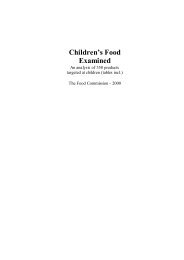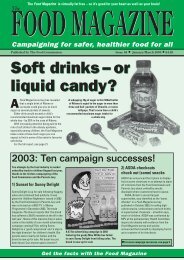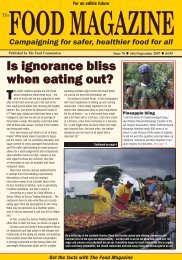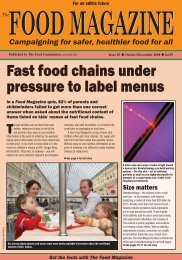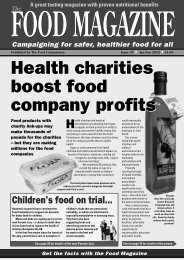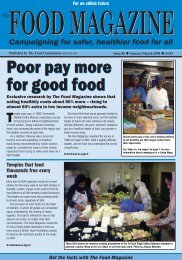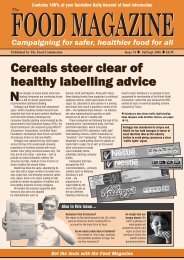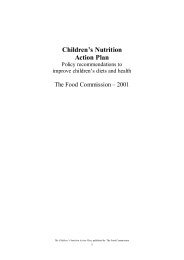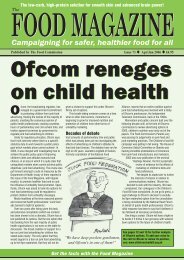Food Magazine - The Food Commission
Food Magazine - The Food Commission
Food Magazine - The Food Commission
You also want an ePaper? Increase the reach of your titles
YUMPU automatically turns print PDFs into web optimized ePapers that Google loves.
nutrition<br />
Nutrition advice<br />
gets hijacked<br />
<strong>The</strong> American government has decided to rewrite the food<br />
pyramid, turning straightforward health advice into little<br />
more than fudge. That's nothing new, argues Kath Dalmeny –<br />
the food industry has been doing it for years!<br />
In the UK, the standard representation of the<br />
'balance of good health' is a plate of food.<br />
<strong>The</strong> circular plate is divided up like a pie<br />
chart, showing the proportions of different foods<br />
that make up a healthy diet, based on good<br />
scientific evidence from population studies linking<br />
dietary choices to health and disease. About one<br />
third of the diet should be carbohydrates; about<br />
one third fruit and vegetables. <strong>The</strong> plate also<br />
shows 15% milk and dairy products and 12%<br />
meat, fish and alternatives. <strong>The</strong> remaining sliver<br />
is eight per cent left over to allow for a small<br />
amount of 'foods containing fat and foods<br />
containing sugar'.<br />
In the US, the same advice has taken the<br />
form of a pyramid of foods. <strong>The</strong> proportions of<br />
the diet are shown as horizontal layers of the<br />
pyramid, the tiny point at the top being the fatty,<br />
sugary foods; the other foods being shown as<br />
larger and larger components of the diet as they<br />
move down the pyramid – starchy carbohydrates<br />
being shown as the solid base.<br />
Recently, scientific advisors to the US<br />
government suggested that a new foundation<br />
layer should be added at the base of the pyramid<br />
– physical exercise – a reminder<br />
that good health is based on<br />
both good food and fitness.<br />
So far so good.<br />
However, this redesign<br />
gave the US<br />
government the<br />
opportunity to<br />
turn the<br />
pyramid<br />
upside<br />
down<br />
and<br />
shake it, to get rid of some troublesome demons.<br />
For a start, the food industry has always insisted<br />
that physical exercise is more important than<br />
food when it comes to tackling America's most<br />
visible health problem – obesity. Simply putting a<br />
thin foundation layer of physical exercise into the<br />
normal pyramid was not nearly enough. So the<br />
whole pyramid has now become a set of stairs<br />
up which a stylised figure endlessly climbs.<br />
In an animation to explain the meaning of the<br />
pyramid (www.mypyramid.gov), the physical<br />
exercise figure literally turns the traditional<br />
pyramid on its side and shakes the carefully<br />
categorised foods into an unrecognisable heap.<br />
And that is where they stay. All equal under the<br />
eyes of God, in just the American way.<br />
Each portion of the pyramid has its own<br />
bright colour and points skywards in a positive<br />
'just eat more' sort of a way. Graphically, the<br />
vertical bars that now divide the pyramid look very<br />
similar in size and emphasis; but now there is no<br />
hierarchy. <strong>The</strong> upbeat pro-industry message is:<br />
All food is good (as long as you run up and<br />
down a pyramid to wear off what you've eaten).<br />
One of the most politically interesting aspects<br />
of the new pyramid is that the section entitled<br />
'foods containing fat, foods containing<br />
sugar' now refers only to oils. Sugary<br />
foods have completely disappeared<br />
and only some bland and unhelpful<br />
advice remains: 'choose your oils<br />
carefully'. Does the lack of sugary<br />
products in any of the pyramid<br />
sections mean that the<br />
government has finally<br />
admitted they are not<br />
<strong>The</strong> US pyramid<br />
before (left)<br />
and in 2005<br />
(right)<br />
necessary for a healthy diet Have they been<br />
banned, or magically whisked away from under<br />
the noses of overweight Americans Or is it that<br />
the government has bowed to pressure from the<br />
sugar industry<br />
Marion Nestle is a professor of nutrition at<br />
New York University who served as a nutrition<br />
and scientific adviser to the US government<br />
when official dietary guidelines were being<br />
written in America. Her reports illustrate that<br />
drawing up official dietary advice is 'an interplay<br />
of give-and-take, bullying, boredom and,<br />
eventually, compromise among a group of<br />
people who entered the process with differing<br />
opinions and agendas'.<br />
At the beginning of 2003 the World Health<br />
Organization (WHO) issued the report Diet,<br />
Nutrition & the Prevention of Chronic Diseases,<br />
which also recommended that sugar (excluding<br />
natural sugars in milk and fruit) should exceed<br />
no more than 10% of the calories in a person's<br />
diet. It also classified as 'probable' or<br />
'convincing' the adverse effects of the high intake<br />
of sugar-sweetened drinks and heavy marketing<br />
of high-calorie foods and fast-food outlets. <strong>The</strong><br />
US Sugar Association condemned the report as<br />
'unfair', 'misguided' and 'misleading', and lobbied<br />
the US Congress to withdraw its annual $406m<br />
funding for the WHO unless the sugar<br />
recommendation was scrapped. <strong>The</strong> Sugar<br />
Association and the US National Soft Drinks<br />
Association maintained that sugar can safely<br />
form one quarter of a person's calorie intake.<br />
And now America's<br />
principal tool for dietary<br />
education contains no<br />
reference to sugar<br />
at all.



